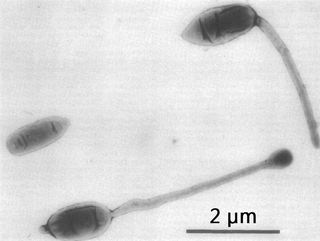Related Research Articles

The Hyphomicrobiaceae are a family of bacteria. Among others, they include Rhodomicrobium, a genus of purple bacteria.
Brucella anthropi is a bacterium. The type strain is strain CIP 82.115. O. anthropi strains are rod-shaped, aerobic, gram-negative, non-pigmented and motile by means of peritrichous flagella. They are emerging as major opportunistic pathogens.
Brucella microti is a species of bacteria first isolated from the common vole, Microtus arvalis. Its genome has been sequenced. It is Gram-negative, non-motile, non-spore-forming, and coccoid, with the type strain CCM 4915T. It is pathogenic.
Brucella lupini is a non-rhizobial root-nodulating bacterium. It nodulates Lupinus albus, hence its name. Strain LUP21T is the type strain.
Brucella cytisi is a non-rhizobial root-nodulating bacterium. It nodulates Cytisus scoparius, hence its name. Strain ESC1T is the type strain.
Brucella grignonensis is a bacterium. Its type strain is OgA9aT.
Brucella inopinata is a Gram-negative, nonmotile, non-spore-forming coccoid bacterium, first isolated from a breast implant infection site. Its type strain is BO1T. It is a potential cause of brucellosis.
Brucella tritici is a species of bacteria first isolated from wheat rhizoplane. Its type strain is SCII24T.
Brucella oryzae is an endophytic bacterial species. It is non-pigmented, motile and Gram-negative, with type strain MTCC 4195T.
Brucella ciceri is a gram-negative, oxidase- and catalase-positive, aerobic bacteria from the genus of Brucella which was isolated from Cicer arietinum in Pakistan.
Brucella daejeonensis is a gram-negative, nitrate-reducing aerobic, non-spore-forming, rod-shaped bacteria from the genus of Brucella which was isolated in Daejeon in South Korea.
Brucella gallinifaecis is a gram-negative, non-spore-forming, rod-shaped bacteria from the genus of Brucella which was isolated from chicken faeces in Germany.
Brucella haematophila is a gram-negative, oxidase-positive, non-spore-forming, non-motile bacteria from the genus of Brucella which was isolated from a man in Falun in Sweden.
Brucella intermedia is a bacterium from the genus of Brucella. It was first described by Velasco and others in 1998. It causes diseases in humans only rarely, with single case reports of cholangitis following liver transplantation, bacteremia in a patient with bladder cancer, a pelvic abscess after abdominal surgery, dyspepsia, endophthalmitis in the presence of a foreign body, pneumonia, and endocarditis.
Brucella pecoris is a gram-negative, oxidase-positive, non-spore-forming, rod-shaped non-motile bacteria from the genus of Brucella which was isolated from genitourinary lymph node of a sheep in Bosnia and Herzegovina.
Brucella pituitosa is a gram-negative, oxidase-positive and catalase-positive, non-spore-forming, non-motile bacteria from the genus of Brucella which was isolated from industrial environment in Sweden.
Brucella pseudintermedia is a gram-negative, non-spore-forming, motile bacteria from the genus of Brucella with a subpolar flagella which was isolated from human axillary swab in Montpellier in France.
Brucella pseudogrignonensis is a gram-negative, oxidase-positive, non-spore-forming, non-motile bacteria from the genus of Brucella which was isolated from blood of a man in Göteborg in Sweden.
Brucella rhizosphaerae is a gram-negative, oxidase-positive bacteria from the genus of Brucella which was isolated from rhizosphere from a potato in Austria.
Brucella endophytica is a Gram-negative, aerobic, rod-shaped and bacteria from the genus of Brucella which has been isolated from the roots of the plant Glycyrrhiza uralensis from Yuli County in China.
References
- ↑ Euzéby JP, Parte AC. "Brucella". List of Prokaryotic names with Standing in Nomenclature (LPSN). Retrieved May 15, 2021.
- ↑ "Straininfo of Ochrobactrum thiophenivorans". Archived from the original on 2014-09-15. Retrieved 2014-09-09.
- ↑ Hördt A, García López M, Meier-Kolthoff JP, Schleuning M, Weinhold LM, Tindall BJ, Gronow A, Kyrpides NC, Woyke T, Göker M (2020). "Analysis of 1,000+ Type-Strain Genomes Substantially Improves Taxonomic Classification of Alphaproteobacteria". Front. Microbiol. 11: 468. doi: 10.3389/fmicb.2020.00468 . PMC 7179689 . PMID 32373076.
- ↑ UniProt
- ↑ Kampfer, P.; Sessitsch, A.; Schloter, M.; Huber, B.; Busse, H. -J.; Scholz, H. C. (2008). "Ochrobactrum rhizosphaerae sp. nov. And Ochrobactrum thiophenivorans sp. nov., isolated from the environment". International Journal of Systematic and Evolutionary Microbiology. 58 (6): 1426–31. doi: 10.1099/ijs.0.65407-0 . PMID 18523190.
- ↑ Deutsche Sammlung von Mikroorganismen und Zellkulturen